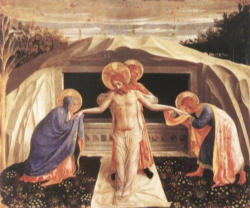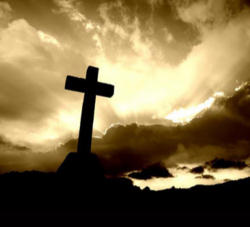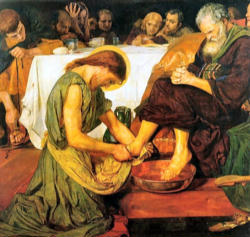“Beginning with the Easter Triduum as its source of light, the new age of the Resurrection fills the whole liturgical year with its brilliance. Gradually, on either side of this source, the year is transfigured by the liturgy” (Catechism of the Catholic Church)
The Easter Triduum begins with the Vigil of Holy Thursday. It marks the end of the forty days of Lent and the beginning of the three-day celebration of the death and resurrection of Jesus Christ – Holy Thursday, Good Friday and Easter Vigil/Easter Sunday. The Fathers of the Second Vatican Council reminded us of the extraordinary significance of the Triduum in these words : “Christ redeemed us all and gave perfect glory to God principally through his paschal mystery: dying he destroyed our death and rising he restored our life. Therefore the Easter Triduum of the passion and resurrection of Christ is the culmination of the entire liturgical year.” (General Norms for the Liturgical Year and the Calendar, # 18)
The Forty Days of Lent were a time of preparation for these great “Three days”, which is what Triduum means. These three days lead us to an empty tomb and then into an Octave, eight days, of celebrating the Resurrection of Jesus Christ which is the victory celebration for the Christian. They also introduce an entire liturgical season, the Easter Season, which lasts for Fifty days until Pentecost.
The Catechism of the Catholic Church (CCC) exhorts us to remember that “Beginning with the Easter Triduum as its source of light, the new age of the Resurrection fills the whole liturgical year with its brilliance. Gradually, on either side of this source, the year is transfigured by the liturgy. It really is a “year of the Lord’s favor.” The economy of salvation is at work within the framework of time, but since its fulfillment in the Passover of Jesus and the outpouring of the Holy Spirit, the culmination of history is anticipated “as a foretaste,” and the kingdom of God enters into our time.
“Therefore Easter is not simply one feast among others, but the “Feast of feasts,” the “Solemnity of solemnities,” just as the Eucharist is the “Sacrament of sacraments” (the Great Sacrament). St. Athanasius calls Easter “the Great Sunday” and the Eastern Churches call Holy Week “the Great Week.” The mystery of the Resurrection, in which Christ crushed death, permeates with its powerful energy our old time, until all is subjected to him.” (CCC #1168, 1169)
The real question is not whether we will mark time but how we will do so? For the Christian time is not meant to be a tyrant ruling over us with impunity. Rather, it is a teacher, inviting and instructing us to choose to enter more fully into our relationship with the Lord and in Him with one another for the world. Time is not our enemy, but our friend. It is a part of the redemptive loving plan of a timeless God who, in His Son, the Timeless One, came into time to transform it from within.
The Lord gives us time as a gift and intends it to become a field of choice and a path to holiness in this life and the window into life eternal. Through time the Lord offers us the privilege of discovering His plan for our own life pilgrimage. Through time He invites us to participate in His ongoing redemptive plan, through His Son Jesus Christ who has been raised, by living in the full communion of His Church which is the seed of the kingdom. That redemptive plan will find its final fulfillment in the recreation of the entire cosmos in Christ. Time is the road along which this loving plan of redemption and re-creation proceeds.
At the very epicenter of our Liturgical Calendar are the great Three days we will celebrate, Holy Thursday, Good Friday and the Resurrection of the Lord, the Sacred Triduum. Good Liturgy is not simply a re-enactment of something that happened over 2000 years ago but an actual participation in the events themselves through living faith. These events are outside of time and made present in our Liturgical celebrations and in our reception of the Sacraments. Just as every Mass/Divine Liturgy is an invitation to enter into the sacrifice of Calvary which occurred once and for all.
We will soon attend the Last Supper and receive the gift of the Holy Eucharist, the Body, Blood Soul and Divinity of Jesus Christ. We will enter into the deep meaning of the Holy Priesthood. We will be invited to pour ourselves out like the water in the basins used to wash feet on Holy Thursday. We will be asked with the disciples in the Gospel accounts we will hear proclaimed to watch with the Lord. We will be invited to enter with Him into his anguish by imitating His Holy surrender in his Sacred Humanity in the Garden of Gethsemane.
Through the stark and solemn Liturgy of the Friday we call “Good”, we will stand at the Altar of the Cross where heaven is rejoined to earth and earth to heaven, along with the Mother of the Lord. We will enter into the moment that forever changed – and still changes – all human History, the great self gift of the Son of God who did for us what we could never do for ourselves by in the words of the ancient hymn of the Church, the Exultet, “trampling on death by death”. We will wait at the tomb and witness the Glory of the Resurrection and the beginning of the New Creation. The Liturgical year in the words of a great liturgist Monsignor Peter Elliott “… transforms our time into a sacrament of eternity.” Let us enter fully into the Sacred Triduum Liturgies. The Great Three Days of Holy Thursday, Good Friday and Easter Invite Us into Heart of the Mystery of Faith.


